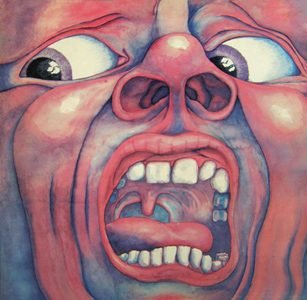Released in 1969, In the Court of the Crimson King marks the formidable debut of King Crimson, a band that would go on to become one of the most influential forces in progressive rock. The album emerged at a time when rock music was undergoing rapid evolution, with bands like Pink Floyd, Yes, and Genesis experimenting with complex structures, extended compositions, and a blend of rock, jazz, and classical influences. King Crimson, however, distinguished themselves by crafting a sound that was darker, more mysterious, and more intensely atmospheric than many of their contemporaries.
In the context of the late 1960s, In the Court of the Crimson King represented both a bold statement of artistic ambition and a radical departure from the prevailing trends in rock music. While many bands of the era were pushing the boundaries of psychedelic rock or embracing the burgeoning folk-rock movement, King Crimson aimed to transcend the limits of what rock music could express. They sought to merge the raw power of rock with the sophistication of classical music and the improvisational freedom of jazz, creating a soundscape that was as cerebral as it was visceral.
Artistic Intentions
Robert Fripp, the band’s guitarist and primary creative force, envisioned the album as an exploration of contrasting emotions and sonic textures—a reflection of the chaotic and uncertain times. In interviews and album notes, Fripp and lyricist Peter Sinfield expressed their desire to craft music that was both innovative and deeply evocative, drawing listeners into a world that was both fantastical and eerily familiar. With this album, King Crimson sought to evoke a sense of grandeur and menace, capturing the tumultuous spirit of the age while also creating something timeless and otherworldly.
The result is an album that not only redefined the possibilities of rock music but also established King Crimson as pioneers of progressive rock, a genre that would go on to influence countless artists in the decades to come. In the Court of the Crimson King is not merely a collection of songs; it is a cohesive artistic statement, a sonic journey that challenges the listener’s perceptions and leaves a lasting impact long after the final notes fade away.
Sonic Exploration

In the Court of the Crimson King is a masterclass in sonic exploration, where every element of production and arrangement is meticulously crafted to create an immersive auditory experience. The production quality of the album is strikingly crisp and clear, especially for its time. Unlike many rock records of the late 1960s, which often embraced a raw, lo-fi aesthetic, King Crimson opted for a pristine sound that allows each instrument to shine. This clarity in production serves to enhance the album’s intricate arrangements, ensuring that the layers of sound are both distinguishable and impactful.
Musical Arrangements
The musical arrangements on the album are nothing short of revolutionary. King Crimson employs a diverse array of instruments, including mellotron, flute, saxophone, and an arsenal of percussion, alongside the traditional rock setup of guitar, bass, and drums. This eclectic mix is orchestrated in a way that creates vast, dynamic soundscapes—alternating between delicate passages and thunderous crescendos. The opening track, “21st Century Schizoid Man,” is a prime example of this approach, with its explosive brass sections and frenetic guitar riffs juxtaposed against sections of intricate, jazzy improvisation. The vocals, delivered with a raw intensity by Greg Lake, cut through the dense arrangements, adding a layer of urgency and emotion that complements the chaotic energy of the instrumentation.
One of the most innovative aspects of the album is its use of the mellotron, which would become a signature sound for King Crimson. The mellotron, with its haunting, orchestral tones, is used to create vast, sweeping textures that lend a cinematic quality to tracks like “Epitaph” and the title track, “The Court of the Crimson King.” These arrangements are not just innovative for their time—they still resonate as fresh and boundary-pushing today, reflecting the band’s ambition to craft a sound that was both otherworldly and deeply emotional.
Genre Elements
In terms of genre, In the Court of the Crimson King is a pioneering work that defies easy categorization. It is often hailed as one of the first true progressive rock albums, blending elements of rock, jazz, classical, and even avant-garde music into a cohesive whole. The album’s genre-blending is done with such finesse that it never feels forced or gimmicky. Instead, it serves to create a unique sonic identity for the band—one that would influence the development of progressive rock throughout the 1970s and beyond. Tracks like “I Talk to the Wind” delve into pastoral, almost folk-like territory, while “Moonchild” ventures into experimental, ambient soundscapes that challenge the listener’s expectations of what rock music can be.
Lyrical Analysis

The lyrics of In the Court of the Crimson King are as intricate and evocative as its music, weaving together themes of dystopia, existential angst, and the frailty of the human condition. Penned by Peter Sinfield, the band’s lyricist and creative visionary, the words on this album are both abstract and deeply resonant, creating a tapestry of imagery that is open to interpretation yet unmistakably impactful.
At the heart of the album lies a meditation on the tensions and contradictions of the modern world. The opening track, “21st Century Schizoid Man,” is a scathing indictment of war, political corruption, and societal decay. With lines like “Blood rack, barbed wire / Politicians’ funeral pyre,” the song paints a grim picture of a world teetering on the brink of self-destruction. This theme of chaos and disillusionment recurs throughout the album, forming a bleak backdrop against which the band explores the inner turmoil of the individual.
Lyrical Depth
The lyrics are not only thematically rich but also steeped in poetic depth. Sinfield’s writing is often abstract, laden with metaphor and allusion, inviting listeners to delve into multiple layers of meaning. In “Epitaph,” for instance, the line “The wall on which the prophets wrote / Is cracking at the seams” evokes a sense of impending doom and the collapse of ideals. The imagery is vivid yet elusive, allowing for a range of interpretations—whether it be the disintegration of societal values or a personal reckoning with mortality. This abstract approach extends to songs like “Moonchild,” where the lyrics drift into the surreal, evoking a dreamlike atmosphere that is more about mood than narrative clarity.
Despite the often cryptic nature of the lyrics, their emotional impact is undeniable. Sinfield’s words, paired with Greg Lake’s emotive vocal delivery, stir a deep sense of melancholy and introspection. “Epitaph,” with its refrain “Confusion will be my epitaph,” captures a profound sense of despair and helplessness that resonates with the listener on a primal level. Even the more fantastical elements of the title track, “The Court of the Crimson King,” contribute to the album’s overall mood of grandiosity tinged with a foreboding sense of collapse. The repeated line “The court of the Crimson King” becomes a powerful, almost hypnotic mantra, imbuing the song with an air of tragic inevitability.
Recurring Themes
The recurring motifs throughout the album—images of kings and prophets, moonlit nights, and chaotic, crumbling worlds—further enhance its thematic cohesion. These motifs not only link the songs together but also reinforce the album’s overarching exploration of power, fragility, and the passage of time. The lyrics, in their complexity and ambiguity, reflect the uncertainty of the era in which the album was created, while also transcending it to speak to universal human experiences.
Cohesion and Flow

In the Court of the Crimson King is not just a collection of songs but a meticulously crafted journey, where each track contributes to an overarching narrative and emotional progression. The album’s cohesion and flow are among its most remarkable qualities, creating an immersive experience that pulls the listener from the chaotic opening notes to the haunting final echoes.
Track Progression
The album begins with a powerful statement in “21st Century Schizoid Man,” a track that sets the tone for the entire record with its aggressive, jagged rhythms and biting commentary. The transition from this explosive opener to the serene, almost ethereal “I Talk to the Wind” is seamless, despite the stark contrast in musical style. This shift in tone isn’t jarring; rather, it feels like a natural descent from the external chaos of the world into a more introspective, contemplative space. The softer, more melodic elements of “I Talk to the Wind” provide a necessary counterbalance to the intensity of the first track, guiding the listener deeper into the album’s world.
As the album progresses, the tracks flow into one another with a sense of deliberate pacing. “Epitaph,” with its somber, reflective mood, follows “I Talk to the Wind” as a logical continuation of the album’s exploration of existential themes. The lush mellotron swells and Greg Lake’s mournful vocals create a seamless bridge between the two songs, maintaining the album’s emotional intensity while gradually building a sense of despair and foreboding. This progression mirrors the thematic journey of the album—from the outer turmoil of “21st Century Schizoid Man” to the inner turmoil expressed in “Epitaph.”
“Moonchild” serves as a pivotal moment in the album’s flow, with its extended instrumental passage that blurs the line between composition and improvisation. The track begins with a gentle, almost lullaby-like melody before dissolving into a dreamlike sequence of sparse, abstract sounds. This transition might be challenging for some listeners, but it’s essential to the album’s overall flow, providing a moment of reflection and introspection before the grandeur of the final track. The ambient textures of “Moonchild” create a sense of suspension, allowing the listener to drift before being drawn back into the more structured and climactic closing of the album.
The album culminates with the title track, “The Court of the Crimson King,” which ties together the thematic and emotional threads that have been woven throughout. The song’s majestic, orchestral arrangement and cyclical structure give it a sense of finality, as if the listener has reached the end of a long, epic journey. The recurring refrain of “The Court of the Crimson King” echoes back to the earlier motifs of power and decay, bringing the album’s exploration of these themes to a poignant close. The track’s grand, almost cinematic quality ensures that the album ends on a high note, leaving a lasting impression of both awe and melancholy.
Thematic Consistency
Thematic consistency is one of the album’s greatest strengths. Despite the varied musical styles and moods explored across the five tracks, there is a unifying thread that runs through the entire work. The themes of dystopia, existential angst, and the collapse of order are present in every song, whether explicitly in the lyrics or implicitly in the mood and tone of the music. This consistency creates a cohesive narrative arc, making the album feel like a singular, unified work rather than a collection of disparate pieces.
In terms of emotional progression, In the Court of the Crimson King is masterfully constructed. The album takes the listener on a journey from the visceral anger of “21st Century Schizoid Man” through moments of calm introspection, despair, and finally to a cathartic resolution. Each track builds upon the last, creating a sense of momentum that carries the listener through the album’s various emotional landscapes without ever feeling disjointed or uneven.
Standout Tracks and Moments
While In the Court of the Crimson King is a cohesive masterpiece, certain tracks and moments stand out for their sheer artistic merit, innovation, and emotional depth. These elements not only define the album but also highlight King Crimson’s extraordinary talent and their ability to push the boundaries of rock music.
Key Tracks
“21st Century Schizoid Man”
This opening track is a tour de force that immediately grabs the listener’s attention with its blistering intensity. It stands out for its aggressive fusion of hard rock, jazz, and avant-garde elements, a bold statement that sets the tone for the entire album. The song’s intricate time signatures, distorted guitar riffs, and ferocious saxophone solos are a testament to the band’s technical prowess and willingness to experiment. Lyrically, the song’s dark, dystopian imagery and the frenzied delivery of Greg Lake’s vocals create a sense of urgency and chaos, making it one of the most powerful tracks on the album.
“Epitaph”
“Epitaph” is a standout for its emotional weight and lyrical profundity. The song’s orchestral mellotron arrangements, combined with Lake’s mournful vocals, create an atmosphere of despair and reflection. The lyrics, filled with apocalyptic imagery and existential dread, resonate deeply, encapsulating the album’s themes of uncertainty and the collapse of societal ideals. The haunting refrain “Confusion will be my epitaph” lingers long after the song ends, making “Epitaph” one of the album’s most memorable and affecting pieces.
“The Court of the Crimson King”
The title track is the album’s grand finale, a majestic composition that encapsulates the album’s thematic and musical ambitions. With its lush mellotron swells, dynamic shifts, and epic scope, the song feels like the culmination of the entire journey. The repetitive, anthemic refrain of “The Court of the Crimson King” is both hypnotic and powerful, leaving a lasting impression of grandeur and melancholic beauty. This track, more than any other, solidifies the album’s place as a landmark in progressive rock.
Memorable Moments
The Frantic Instrumental Break in “21st Century Schizoid Man”
Midway through “21st Century Schizoid Man,” the band launches into a chaotic, high-speed instrumental break that showcases their technical virtuosity. The interplay between Robert Fripp’s distorted guitar and Ian McDonald’s saxophone is electrifying, creating a whirlwind of sound that is both disorienting and exhilarating. This moment captures the essence of King Crimson’s willingness to push musical boundaries, blending rock’s raw power with the complexity of jazz improvisation.
The Mellotron Crescendo in “Epitaph”
One of the album’s most iconic moments is the soaring mellotron crescendo in “Epitaph.” As the song builds to its emotional peak, the mellotron swells to a nearly orchestral level, enveloping the listener in a wall of sound. This moment is not only musically stunning but also deeply moving, as it perfectly complements the song’s lyrical themes of loss and confusion. It’s a powerful example of how King Crimson used innovative instrumentation to enhance the emotional impact of their music.
The Dreamlike Transition in “Moonchild”
“Moonchild” features a fascinating shift from structured song to free-form improvisation. After a gentle, melodic beginning, the track dissolves into an extended instrumental passage where the band experiments with sparse, ambient sounds. This section, filled with delicate guitar plucks, subtle percussion, and eerie silences, creates a dreamlike atmosphere that is both unsettling and mesmerizing. This transition highlights King Crimson’s avant-garde sensibilities and their ability to evoke mood and emotion through unconventional means.
The Climactic Reprise in “The Court of the Crimson King”
As the album nears its conclusion, “The Court of the Crimson King” reprises its central theme with a powerful final chorus. The return of the majestic mellotron, combined with Lake’s commanding vocals, creates a sense of cyclical completion, as if the listener has come full circle. This climactic moment is both triumphant and tragic, perfectly encapsulating the album’s exploration of grandeur, decay, and the passage of time. It’s a fitting end to an album that is as much about the journey as it is about the destination.
Artistic Contribution and Innovation

In the Court of the Crimson King holds a monumental place within the progressive rock genre and the broader music industry. Released in 1969, the album arrived at a pivotal moment when rock music was rapidly evolving, with bands experimenting with longer compositions, complex arrangements, and a blending of musical genres. However, King Crimson didn’t just contribute to this evolution—they redefined it, pushing the boundaries of what rock music could be and setting a new standard for artistic ambition.
Place in Genre/Industry
At the time of its release, In the Court of the Crimson King was unlike anything that had come before it. While contemporaries like Pink Floyd and The Moody Blues were also exploring progressive ideas, King Crimson’s debut album took the concept of progressive rock to a new level of intensity and sophistication. The album’s blend of rock, classical, jazz, and avant-garde influences created a sound that was both innovative and genre-defying. It wasn’t merely a rock album with extended solos and intricate compositions; it was a complete reimagining of what rock music could convey emotionally and intellectually.
In the broader context of the music industry, In the Court of the Crimson King challenged the established norms of popular music. At a time when singles-driven pop and radio-friendly rock dominated the charts, King Crimson released an album that demanded to be experienced as a complete work. Its complex structures, lengthy tracks, and thematic depth made it clear that this was music for listeners willing to engage with it on a deeper level. The album’s success—both critically and commercially—proved that there was a substantial audience for music that transcended conventional formats, influencing countless artists and helping to solidify progressive rock as a legitimate genre.
Innovation
In the Court of the Crimson King is innovative on multiple fronts, from its groundbreaking production techniques to its genre-blending compositions. One of the album’s most significant innovations is its use of the mellotron. While the instrument had been used by other bands, King Crimson employed it in a way that was both dramatic and textural, transforming the mellotron into a central character within the album’s sonic narrative. The orchestral, almost symphonic quality of the mellotron on tracks like “Epitaph” and “The Court of the Crimson King” added a new dimension to rock music, creating lush, immersive soundscapes that were previously unheard of in the genre.
Production
The album’s production, overseen by the band along with Tony Clarke and Robin Thompson, is also noteworthy for its clarity and precision. Unlike many records of the era, which often had a raw, unpolished sound, In the Court of the Crimson King is meticulously produced, with each instrument and vocal part given space to breathe. This attention to detail allowed King Crimson to create a rich, multi-layered sound that was both powerful and nuanced, enhancing the album’s overall impact.
Genre Elements
Another key innovation is the album’s approach to genre. Rather than adhering to a single style, King Crimson seamlessly blended elements of rock, jazz, classical, and avant-garde music, creating a sound that was uniquely their own. Tracks like “21st Century Schizoid Man” exemplify this genre-blending, with its fusion of heavy rock riffs, jazz improvisation, and dissonant, almost industrial noise. This eclecticism was not just a novelty—it was integral to the album’s artistic vision, reflecting the band’s desire to break down musical barriers and explore new territories.
Themes
Thematically, the album was also groundbreaking. The lyrics, written by Peter Sinfield, delve into dark, complex themes such as dystopia, existentialism, and the collapse of civilization. These were not the typical subjects of rock lyrics at the time, which tended to focus on love, rebellion, or psychedelia. King Crimson’s willingness to tackle such weighty themes, and to do so in a way that was both poetic and thought-provoking, set them apart from their peers and added a new intellectual dimension to rock music.
Closing Thoughts
In the Court of the Crimson King is an album that transcends its time, standing as both a cornerstone of progressive rock and a timeless artistic achievement. Its strengths are numerous: from the innovative use of the mellotron and genre-blending compositions to its rich lyrical themes and meticulous production quality. King Crimson’s debut not only pushed the boundaries of rock music but also set a new standard for what an album could be—a cohesive, immersive experience that challenges the listener both emotionally and intellectually.
Strengths & Weaknesses
One of the album’s most significant strengths is its cohesion. Each track contributes to the overarching narrative and emotional journey, making the album feel like a singular, unified work rather than a collection of individual songs. This thematic and musical consistency is rare, even in the realm of progressive rock, and it’s what gives the album its enduring power and appeal.
The only potential weakness, if it can be called that, lies in the album’s complexity and ambition, which might be challenging for some listeners. The extended instrumental passages, abstract lyrics, and dense arrangements require a level of engagement and patience that casual listeners may not be prepared for. However, this very complexity is also what makes the album so rewarding for those willing to delve into its depths. It’s an album that reveals more with each listen, offering new insights and experiences as the listener becomes more familiar with its intricate layers.
Place in Career
As for its place in King Crimson’s career, In the Court of the Crimson King remains a defining work. It laid the foundation for the band’s future explorations and established their reputation as innovators in the rock genre. While King Crimson would continue to evolve and experiment with their sound in subsequent albums, this debut remains their most iconic and influential work, the one that set the stage for all that would follow.
In terms of its impact on listeners, the album has the potential to be both a mind-expanding journey and a deeply emotional experience. It challenges conventional notions of rock music and invites the listener to enter a world of complex emotions, dark themes, and intricate soundscapes. For those who embrace its depth and ambition, it is an album that can leave a lasting impression, altering the way they think about music and its possibilities.
Official Rating
This album deserves a perfect 10 out of 10 not only for its groundbreaking innovation and technical mastery but also for its profound emotional and intellectual impact. In the Court of the Crimson King is more than just a milestone in progressive rock; it’s a masterpiece that continues to resonate with listeners decades after its release. Its ability to evoke a wide range of emotions, from awe to melancholy, and its success in creating a cohesive, immersive experience make it a standout in both King Crimson’s discography and the history of rock music. This is an album that has not only stood the test of time but has also continued to inspire and influence generations of musicians and listeners alike.
